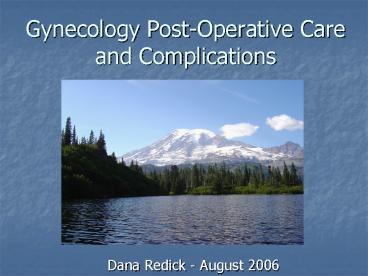Gynecology PostOperative Care and Complications - PowerPoint PPT Presentation
1 / 16
Title:
Gynecology PostOperative Care and Complications
Description:
Gynecology PostOperative Care and Complications – PowerPoint PPT presentation
Number of Views:8301
Avg rating:5.0/5.0
Title: Gynecology PostOperative Care and Complications
1
Gynecology Post-Operative Care and Complications
- Dana Redick - August 2006
2
(No Transcript)
3
Estimates of Complications
- Abdominal Hysterectomy
- 0.9 (including minor complications 3-15)
- Vaginal Hysterectomy
- 1.2
- Laparoscopic Hysterectomy (LAVH and TLH)
- 1.7
- Laparoscopic Procedures
- 0.1 to 1.7 (including minor complications 8)
- Pelvic support procedures
- 0.33 mortality rate
- 4.8 readmission
Mcpherson, K BJOG 2004 Chapron, C et al. Human
Reproduction 2002 Levy, BS, et al. JAAGL1994 Shen
CC, et al. JAAGL 2003 Hasson HM - Obstet Gynecol
- 2000 Sultana CJ et al. Am J Obstet Gynecol
1997 Telindes Gynecology, 2001
4
Types of Complications
- Organ Injury
- Vascular
- Bowel
- Bladder
- Ureteral
- Infectious Morbidities
- Sepsis
- Wound infection
- Pneumonia
- Urinary Tract infection
- Neuropathies
- Other
- Thromboembolic
- Adhesions
- Fistulas
- Lymphedema
- Incision Hernia
.but first a few quick reminders before entering
the Operating Room
5
In Office Procedures
- Same Informed Constent Process (written constent
for IUD placement and LEEPs) - Appropriate equipment, staff assistance, and good
technique
6
Peri-operative Strategies
- Consent process
- Designated appointment for pre-operative
discussion - Written materials
- Family involvement
- Blood transfusion
- Medical evaluation
- Focused Cardiac and Respiratory History
- Smoking cessation
- Risk assessment for DVT prophylaxsis
- Discussion of Contraceptives and Hormone
Replacement - Bowel, skin and vaginal preparation
- Low residue diet, oral antibiotic and/or
mechanical bowel preparation - Perioperative Antibiotics
- Topical estrogen for atrophic tissues
7
BLEEDING
- Excessive bleeding in 1-3 of hysterectomies
generally recognized intraoperatively - Post Operative Recognition
- Vital sign changes
- Decreased urinary output
- Vaginal Bleeding
- Flank pain with retroperitoneal bleeding
- Decreasing Hematocrit
- Post Operative Management
- Physical examination
- Return to OR
8
Bowel Injuries and Illeus
- 4-5 Incidence of Illeus and 0.3 Incidence of
Bowel injury and with hysterectomies - Recognition and Management of Illeus
- Nausea, vomiting, and distended abdomen
- Adequate hydration and electrolyte management
- Bowel rest and consider use of Nasogastric tube
- Recognition and Management of Injury
- Visually with immediate repair
- Nausea, emesis, fever, peritionitis
- Difficult at times to discern injury vs illeus
- Delayed recognition requires return to OR
9
Bladder Injuries
- 0.1 to 0.5 incidence
- Recognition
- Visual inspection
- Retrofilling
- Cystoscopy
- Management
- Surgical Repair Immediately
- Post-operative drainage
- Fistula Repair
10
Ureteral Injuries
- 0.2-1.3 incidence
- Lowest with Vaginal approach
- Highest with Laparascopic approach
- Recognition and Management
- Visualize uterers (palpation inadequate)
- Stents not proven to be helpful
- Cystoscopy with Indigo Carmine
- Surgical Repair (Consult Urology)
11
Infectious Morbidities
- Combined 9 incidence of wound infection, pelvic
cellulitis, vaginal cuff abscess, and pelvic
abscesses among women who received prophylactic
antibiotics with hysterectomy - 1-5 rate of symptomatic urinary tract infection
- 30-50 of women undergoing hysterectomy develop a
fever post operatively - Recognition and Management
- Remember 5 Ws (Wind, Wound, Water, Walking,
Wonder Drugs) - History, Physical Exam, and Labs/Studies
- Treat with incentive spirometry, ambulation, and
Antibiotics
12
Thromboembolic Complications
- Deep Venous Thrombous
- 7-45 incidence in general and malignant
gynecologic surgeries - Asymmetric Edema, Warmth, Tenderness
- Ultrasound (90 sensitive for proximal leg veins)
- Anticoagulation
- Pulmonary Embolus
- 0.1-5 incidence
- Tachycardia, Tachypnea, Decreased oxygen
saturation - Spiral CT, VQ scan
- Anticoagulation
13
Neuropathies and Nerve Entrapment
- 1.9 Incidence in one University of Florida
Series - Generally related to positioning and retractor
placement - Presents with motor weakness and sensory defects
- Treatment with physical therapy or sometimes
exploration for painful nerve entrapment
14
Case 1
- 24 year old female who presents with nausea,
anorexia, and abdominal pain. She is now POD 3
from a laparoscopic left oopherectomy and lysis
of adhesions for dermoid cyst - Cyst ruptured during case
- Bowel resected from cyst and left pelvic side
wall - Discharge 2 hours after surgery without
complications
What next?
15
Case 2
- 45 year female now POD1 who underwent a vaginal
hysterectomy for menorhagia and has failed to
void after removal of foley catheter. - Any additional history questions
- Physical Exam
- Studies, Labs, and/or Other intervertions
What next?
16
Case 3
- 72 year old female now POD2 from a vaginal
hysterectomy, anterior repair and uretheral sling
placement. Nurse calls reporting patient trying
to remove IV and seems confused. - Additional History Questions
- Physical Exam
- Studies, Lab, and/or other inventions
What next?

